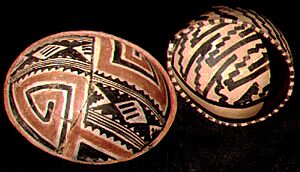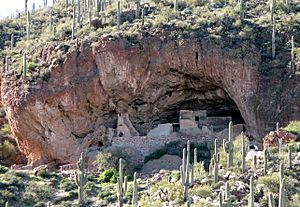Salado culture facts for kids
The Salado culture was a group of people who lived in the Tonto Basin of southeastern Arizona. They lived there from about 1150 CE (which means Common Era, like AD) until the 15th century. This culture is also sometimes called the Salado Horizon.
The Salado people had special ways of life that make them unique. They made colorful pottery called Salado Polychrome. They lived in villages with walls made of adobe, which is a type of mud brick. Unlike some other groups, they buried their dead instead of burning them.
The Salado were skilled farmers. They used simple ways to bring water to their fields, a method called irrigation. They grew important crops like corn, beans, pumpkins, amaranth, and cotton. To add to their food, they also hunted animals and collected wild plants like buds, leaves, and roots. They traded with other groups too. We know this because archaeologists have found seashells from the Gulf of California and macaw feathers from Mexico in Salado sites.
Salado Cliff Dwellings
Many Salado villages in the river valleys are now covered by Theodore Roosevelt Lake. But some of their amazing cliff dwellings still remain. These special homes were built in the 14th century. The Salado people moved up into the hills from the busy valleys to build them.
In 1907, President Theodore Roosevelt protected two of these well-preserved cliff dwellings. They are now known as Tonto National Monument. These homes were built inside natural caves in the siltstone hills around the Tonto Basin.
The Salado used mud and rocks to build their homes, which were like multi-story buildings called pueblos. The Lower Cliff Dwelling had sixteen rooms on its ground floor. Three of these rooms even had a second story! Nearby, there was another section with twelve more rooms. The Upper Cliff Dwelling was much bigger, with thirty-two rooms on the ground floor. Eight of these rooms also had a second story.
Salado Artifacts and Tools
Archaeologists have found many objects that help us understand how the Salado people lived. Their Salado Polychrome pottery was both useful for daily life and beautiful to look at. They were also very good at weaving. They made sandals from strong yucca and agave plant fibers. They also wove tightly coiled baskets.
The Salado used tools made from bone to help them survive in the desert. They grew corn and cotton using more and more advanced irrigation systems. One impressive thing they did was casting copper bells. They made these bells using wax molds, which was a big step in technology for their time.
Salado Natural Environment
The Salt River flows through the Tonto Basin. This river gave the Salado people enough water for their farming and for the animals they hunted. Around the year 1330, the climate changed. The valley became drier, and the water levels dropped.
Today, the Tonto Basin and the surrounding hills are home to many plants and animals. You can find mesquite, Arizona walnut, and sycamore trees. There are also saguaro, cholla, prickly pear, agave, and jojoba cacti and succulents. Higher up, you might see oak, juniper, piñon, and ponderosa pine trees. Wildlife in the area includes deer, rabbits, quail, and other small animals.
See also
 In Spanish: Cultura Salado para niños
In Spanish: Cultura Salado para niños



